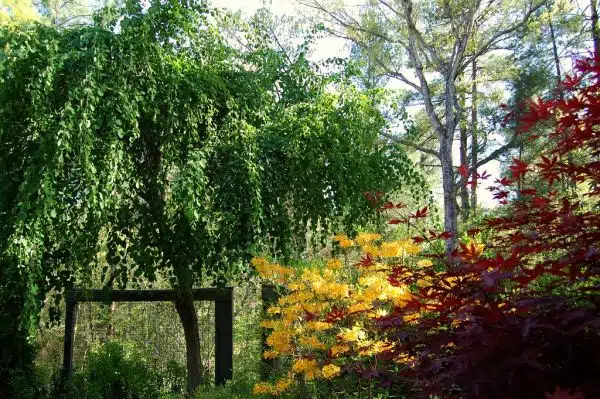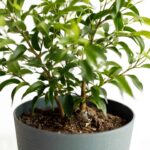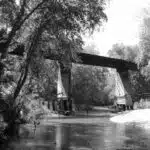Weeping Katsura, a deciduous tree native to Japan and China, is a popular ornamental plant known for its unique weeping habit and stunning foliage. The beauty of this tree is enhanced by the delicate heart-shaped leaves that turn from bright green to yellow, pink, and orange in the fall season. Growing and caring for Weeping Katsura requires attention to detail and adherence to specific guidelines.
In this article, we will delve into the various aspects of cultivating and maintaining Weeping Katsura trees. From the ideal soil type to fertilization methods, our aim is to provide you with comprehensive information that will help you achieve optimal growth and health for your plants. Whether you are an experienced horticulturist or a beginner looking to add some flair to your garden, this guide will serve as a valuable resource for all your Weeping Katsura needs.
Understanding The Weeping Katsura Tree
As the Weeping Katsura tree gracefully sways in the wind, its leaves dance like flames, revealing a beautiful display of autumn colors. This deciduous tree is native to Japan and China and can grow up to 40 feet tall with a similar spread. It has a delicate appearance with drooping branches that sweep the ground.
Pruning needs for the Weeping Katsura are minimal, but it’s essential to maintain its beautiful shape. Prune in late winter or early spring before new growth appears. Remove any dead or damaged branches and thin out areas where there is too much growth. Avoid pruning during the summer months as this can damage the tree’s health.
Seasonal changes also require attention when caring for your Weeping Katsura tree. In spring, it will produce reddish-purple flowers before its foliage emerges. Summer brings large green leaves that gradually change to yellow and apricot hues in autumn before falling off. The bare branches of winter reveal an elegant silhouette that stands out in any landscape design.
To ensure your Weeping Katsura thrives, choosing the right location is crucial. In the next section, we’ll discuss how to select an appropriate site for planting and tips on soil preparation.
Choosing The Right Location
Understanding the Weeping Katsura Tree helps in choosing the right location for its growth and care. As a tree that grows up to 40 feet tall, it requires adequate space and sunlight to thrive. Sun exposure is crucial in determining the ideal location of planting your weeping katsura tree. Ensure it receives at least six hours of direct sunlight daily to stimulate healthy growth.
Soil type is another critical factor to consider when selecting a suitable location for your weeping katsura tree. The soil should be moist, fertile, and well-drained to provide an optimal environment for root development. Avoid soils that are too sandy or heavy with clay content as they affect the water holding capacity of the ground and may lead to poor uptake of nutrients.
To ensure proper sun exposure and soil type, here are three key factors you need to consider:
- Choose a site with full sun exposure – this will provide enough sunlight required for photosynthesis.
- The soil should be well-drained- soil that drains quickly but retains moisture is ideal.
- Choose neutral or slightly acidic soils with a pH range of 6-7.
Incorporating these factors will ensure your weeping katsura tree thrives in its new environment. However, before planting, it’s vital to prepare your soil adequately for optimal growth and prevent any future issues that may arise due to poor soil conditions.
Soil Preparation
Like any other plant, weeping katsuras require proper soil preparation to grow and flourish well. Soil composition and pH levels are the two key factors that determine the health of the tree. Inadequate soil preparation could lead to poor root development, which can result in stunted growth or even death of the tree.
Weeping katsuras grow best in well-drained, loamy soils with a slightly acidic pH level between 5.0 to 6.5. Before planting, it is essential to test your soil’s pH level to ensure it falls within this range. If the pH level is too high or low, you can adjust it by adding organic matter such as compost or peat moss.
The table below provides a breakdown of soil compositions and their ideal percentage for growing weeping katsuras:
| Composition | Ideal percentage |
|---|---|
| Sand | 40% |
| Silt | 40% |
| Clay | 20% |
Proper soil preparation is crucial for the success of growing weeping katsuras. Adequate drainage and optimal pH levels ensure that nutrients are accessible to the roots and allow for proper root development. The next step in ensuring your tree thrives is proper watering and drainage management, which we will discuss in-depth in the subsequent section.
Watering And Drainage
Weeping Katsura trees require frequent and consistent watering but not to the point of saturation. Adequate drainage is also necessary to prevent waterlogging and root rot. It is important to monitor soil moisture levels to ensure the correct amount of water is supplied. To ensure proper drainage, the soil should be amended with organic matter such as compost to improve its water-holding and drainage capabilities.
Watering Amount
To ensure the optimal growth of your weeping katsura, it is important to pay close attention to its watering needs. Overwatering or underwatering can both have negative effects on the health of the tree. The frequency of watering will depend on various factors such as weather conditions and soil type.
In general, weeping katsura trees prefer moist but well-draining soil. It is recommended to water deeply once a week during dry spells or when temperatures rise above 85°F. However, if the soil still feels damp from previous watering, it is best to hold off until the top inch of soil feels dry to the touch. Overwatering can lead to root rot and other diseases, which can be identified by yellowing leaves and a foul smell emanating from the soil.
Proper drainage is also crucial for maintaining healthy weeping katsura trees. Ensure that there are no obstructions in the drainage holes at the bottom of your container or planting area. If you suspect poor drainage may be an issue, consider amending your soil with organic matter or creating a raised bed with improved drainage capabilities. By monitoring and adjusting your watering habits accordingly, you can help ensure that your weeping katsura thrives for years to come.
Drainage Requirements
Maintaining optimal watering and drainage conditions is essential for the healthy growth of weeping katsura trees. In addition to monitoring watering frequency, it is crucial to ensure proper drainage to prevent waterlogging and root rot. Insufficient drainage can cause soil saturation, leading to oxygen deprivation in the root zone, which can stunt growth and cause wilting or yellowing leaves.
To determine if your weeping katsura requires better drainage, it is recommended to conduct a soil test. A soil test can help identify any underlying issues that may hinder proper drainage, such as high clay content or compacted soil. If poor drainage is a concern, consider installing drainage systems or improving existing ones to redirect excess water away from the root zone.
There are various ways to improve drainage in planting areas or containers, including creating raised beds or adding organic matter such as compost or peat moss to the soil mix. Installing French drains or perforated pipes can also help remove excess water and prevent soil saturation. By addressing any issues with drainage and implementing appropriate solutions, you can help ensure that your weeping katsura thrives in a healthy environment conducive to its growth and development.
Fertilization Methods
Weeping Katsura trees require regular fertilizer application to promote healthy growth and development. Fertilizer should be applied during the tree’s growing season, which typically occurs from late spring to early fall. The application rate will depend on several factors, including the age of the tree, soil quality, and nutrient deficiencies.
Before applying fertilizer, it is important to determine if the tree is suffering from any nutrient deficiencies. Common signs of deficiency include yellowing leaves, stunted growth, and poor fruit development. Testing the soil can help identify any deficiencies and determine which type of fertilizer is needed. A balanced fertilizer with equal parts nitrogen, phosphorus, and potassium can be used as a general-purpose fertilizer for most weeping Katsura trees.
When applying fertilizer, it is important to follow the manufacturer’s instructions carefully. Over-fertilization can damage roots and cause excessive leaf growth at the expense of flowering or fruit production. Fertilizer should be applied evenly around the base of the tree and watered in thoroughly. It is recommended to apply fertilizer in early spring before new growth begins and again in mid-summer if necessary.
In summary, fertilization is an essential part of caring for weeping Katsura trees. Proper fertilizer application can help prevent nutrient deficiencies and promote healthy growth. By testing soil quality and following manufacturer instructions for application rates, gardeners can ensure their weeping Katsura trees thrive for years to come.
Transition: Now that we have covered proper fertilization methods for weeping Katsura trees let’s discuss pruning techniques to further enhance their health and beauty.
Pruning Techniques
After properly fertilizing the weeping katsura, it is essential to consider pruning techniques to maintain its aesthetic appeal and health. Timing pruning is a crucial aspect of this process. The best time to prune the tree is during winter when the leaves have all fallen off, and you can easily see the structure of the tree. During this time, it is easier to identify dead or diseased branches that need to be removed.
Shaping techniques are also important in maintaining an attractive appearance for your weeping katsura. These trees grow relatively fast and can quickly become unruly without proper shaping. To achieve this, begin by identifying any branch that rubs against another, and remove it using a clean pruning tool. Additionally, cut back any branch that grows too long or too close to the ground since these can make your tree look unbalanced.
In summary, timing pruning and shaping techniques are two critical aspects of caring for your weeping katsura tree. By regularly performing these tasks, you can ensure that your tree remains healthy and attractive for years to come. In the next section, we will discuss how to deal with pests and diseases that may affect your tree’s growth and development.
Dealing With Pests And Diseases
Pruning is an important part of caring for a Weeping Katsura and should be done in early spring or late fall. Controlling insects is essential for a healthy Weeping Katsura. This can be done by implementing a regular pest control program and monitoring for signs of pests. Fungal diseases can be prevented by mulching, avoiding overhead irrigation, and ensuring adequate air circulation. Fungal diseases can also be treated with fungicide applications when needed. Proper pruning and regular inspection can help to identify and prevent fungal diseases from taking hold. Proper watering and fertilization can also help to prevent fungal diseases from developing in Weeping Katsura.
Pruning
As a horticulturist, one of the most effective practices in dealing with pests and diseases is pruning. A proper pruning schedule can go a long way in keeping your weeping katsura healthy and free from pests and diseases. It is important to use the appropriate pruning tools for the job, such as sharp hand pruners or loppers.
Pruning should be done during the dormant season, which is typically in late winter or early spring before new growth begins. This will promote healthy new growth and reduce the risk of disease transmission. Dead, diseased or damaged branches should be removed first, followed by any branches that are crossing or rubbing against each other.
Regular pruning also helps to maintain the desired shape and size of your weeping katsura. It is important not to over-prune, as this can weaken the tree and make it more susceptible to pests and diseases. As a general rule of thumb, no more than 25% of the tree’s canopy should be removed at one time. By following these guidelines for pruning, you can keep your weeping katsura healthy, vigorous and looking its best.
Controlling Insects
Another crucial aspect of dealing with pests and diseases in your weeping katsura is controlling insects. Insects can cause significant damage to the tree and even lead to its death if not dealt with promptly. As a horticulturist, it is important to use an integrated pest management approach that includes both natural remedies and chemical treatments.
Natural remedies such as neem oil, garlic spray, and insecticidal soap can be effective in controlling insects without harming the environment or beneficial insects. These remedies work by suffocating or repelling the insects, preventing them from feeding on the leaves or stems of your weeping katsura. However, it is important to note that natural remedies may need to be applied more frequently than chemical treatments.
Chemical treatments such as insecticides are also available for controlling insects in your weeping katsura. These treatments work by killing the insects upon contact or ingestion. However, it is important to follow the manufacturer’s instructions carefully when using these chemicals, as they can harm beneficial insects and other wildlife if used improperly. As a horticulturist, it is essential to weigh the benefits and risks of chemical treatments before deciding whether to use them.
In conclusion, controlling insects in your weeping katsura should be approached with care and consideration for both the tree’s health and the environment. By using an integrated pest management approach that includes natural remedies and chemical treatments when necessary, you can keep your weeping katsura healthy and thriving for years to come.
Fungal Diseases
Fungal diseases are another threat that can affect the health of your weeping katsura. These diseases can manifest in various forms, such as leaf spots, powdery mildew, and root rot. Preventive measures are crucial in controlling these diseases since they can quickly spread and cause irreversible damage. Proper cultural practices such as watering the tree at the base rather than overhead and pruning infected areas promptly can prevent the spread of fungal spores.
In addition to preventive measures, treatment options are also available for fungal diseases in your weeping katsura. Fungicides containing copper or sulfur can be effective in treating certain types of fungal infections when applied appropriately. However, it is essential to follow the manufacturer’s instructions carefully when using these chemicals to avoid harming beneficial insects and other wildlife.
It is important to note that prevention methods should always be prioritized over treatment options for fungal diseases. Regular monitoring of your weeping katsura’s health and prompt action when symptoms arise can help prevent the spread of disease and ensure its longevity. As a horticulturist, it is vital to have a thorough understanding of both prevention methods and treatment options when dealing with fungal diseases affecting your trees.
Propagation And Transplanting
Propagation of weeping katsura trees can be done through stem cutting or grafting. Stem cuttings should be taken in late spring to early summer when the tree is actively growing. Cuttings should be 6-8 inches long and taken from new growth that is still soft and green. Remove the leaves from the bottom half of the cutting, dip it in rooting hormone, and plant it in a well-draining soil mixture. Keep the soil moist and place the cutting in a shaded area where it can receive indirect sunlight.
Transplanting weeping katsura trees should be done during dormancy in late fall or early winter. Dig a hole twice as wide as the root ball and deep enough for the top of the root ball to sit level with the ground surface. Carefully loosen any roots that are tightly packed, then place the tree in the hole and backfill with soil. Water thoroughly to settle the soil around the roots.
Pruning frequency for weeping katsura trees depends on personal preference but is typically done once per year in late winter or early spring before new growth starts. Prune any dead, diseased, or broken branches first, then selectively prune to shape and thin out crowded branches. If needed, apply a light application of fertilizer after pruning to encourage healthy growth.
As with all trees, winter care is important for weeping katsura trees. Protect young trees by wrapping them with burlap or other protective material to shield them from cold temperatures and wind damage. Mulching around the base of older trees will help retain moisture and insulate their roots from freezing temperatures. Avoid using salt near weeping katsura trees as they are sensitive to salt damage.
Winter Care
During the winter, it is important to protect your weeping katsura from frost and other harsh weather conditions that can damage or kill the tree. Winter protection for weeping katsura involves a combination of techniques that will help keep the tree healthy and strong throughout the cold months. Here are some tips for winter care:
First, make sure to water your weeping katsura deeply before the ground freezes. This will ensure that the tree has enough moisture to survive during the winter months. Second, apply a layer of mulch around the base of the tree to help insulate its roots and retain moisture in the soil. Third, wrap burlap around the trunk and branches of your weeping katsura to protect it from windburn and sunscald.
Fourth, prune any dead or damaged branches before winter sets in. This will prevent disease from spreading and improve air circulation around the tree. Fifth, consider using frost prevention techniques such as covering your weeping katsura with blankets or plastic sheeting on particularly cold nights.
By following these winter care tips, you can help ensure that your weeping katsura stays healthy and strong throughout the winter months. With proper care, your tree will thrive year after year, providing beauty and shade for generations to come.
Winter Care
To protect your weeping katsura from frost and other harsh weather conditions during winter time, follow these tips:
- Water deeply before ground freezes
- Apply a layer of mulch around base
- Wrap burlap around trunk and branches
- Prune any dead or damaged branches
- Consider using frost prevention techniques
Watering deeply before ground freezes ensures that there is enough moisture for survival during colder months while applying mulch helps insulate its roots and retain soil moisture. Wrapping burlap around trunk and branches protects against windburn and sunscald; pruning any dead or damaged branches prevents disease from spreading and improves air circulation. Lastly, consider using frost prevention techniques such as covering with blankets or plastic sheeting on particularly cold nights.
By following these winter care tips, weeping katsura trees will remain healthy and strong throughout the winter months, providing beauty and shade for generations to come.
Frequently Asked Questions (Faqs
Winter Care is essential for the proper growth and longevity of Weeping Katsura. During winter, the tree goes dormant, and its metabolic activities slow down. The first step to ensuring healthy growth during winter is to provide adequate insulation to the roots. It would be best if you mulched around the base of the tree with at least three inches of organic matter such as leaves or straw. This layer will act as a blanket and protect the roots from frost.
Another important consideration for Weeping Katsura’s winter care is watering. Although the tree is dormant, it still requires moisture to survive. Watering should be done thoroughly but sparingly, and only when necessary. Overwatering can cause root rot, which can lead to stunted growth or even death.
Common problems that Weeping Katsura may face include pests and diseases like Japanese beetle or fungal infections such as leaf spot disease. To prevent these problems from occurring, it is essential to maintain good hygiene by removing fallen leaves and debris around the base of the tree regularly. Additionally, pruning diseased branches promptly and using pesticides when necessary will help keep your tree healthy.
Maintenance tips for Weeping Katsura include regular pruning to promote proper shape and healthy growth. You should also fertilize your tree once a year in early spring with a balanced fertilizer high in nitrogen content to encourage lush foliage development. Finally, monitor your tree closely throughout its growing season for any signs of pests or disease so that you can take action quickly if needed.
In conclusion, proper winter care for Weeping Katsura involves providing adequate insulation for roots and watering sparingly but sufficiently. Common problems that may plague your tree include pests and diseases that can be prevented through good hygiene practices like removing debris regularly and pruning infected branches promptly. Maintenance tips include regular pruning for shape maintenance, fertilizing once a year in early spring with a balanced fertilizer high in nitrogen content, and monitoring your tree closely for any signs of pests or disease.
Conclusion
The Weeping Katsura tree is a beautiful addition to any landscape, but it requires proper care and attention to thrive. Choosing the right location with adequate sunlight, well-draining soil, and regular watering is essential for optimal growth. Fertilization methods and dealing with pests and diseases are important factors to consider when caring for this delicate plant.
Propagation and transplanting require careful planning and execution to ensure successful establishment. Winter care is also critical, as this species is particularly susceptible to cold weather damage. By following these guidelines, gardeners can enjoy the beauty of the Weeping Katsura tree for years to come.
In conclusion, growing and caring for the Weeping Katsura tree requires patience, diligence, and knowledge about its specific needs. Proper location selection, soil preparation, watering techniques, fertilization methods, pest control strategies, propagation and transplanting techniques all play a vital role in ensuring the health and longevity of this stunning plant. With adequate care throughout all seasons of the year, gardeners can enjoy the graceful beauty of the Weeping Katsura tree in their landscapes.
Image Credits
- “Weeping Katsura Tree with ‘Admiral Semmes’ Azalea and Acer ‘Emperor I’” by UGArdener (featured)





























